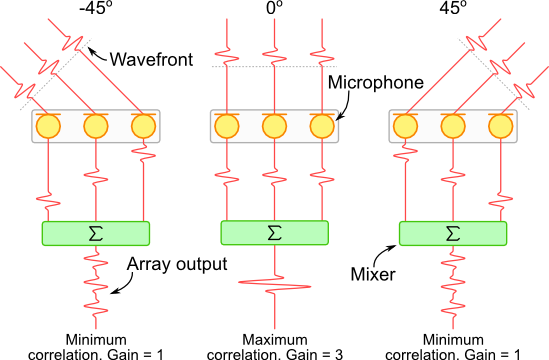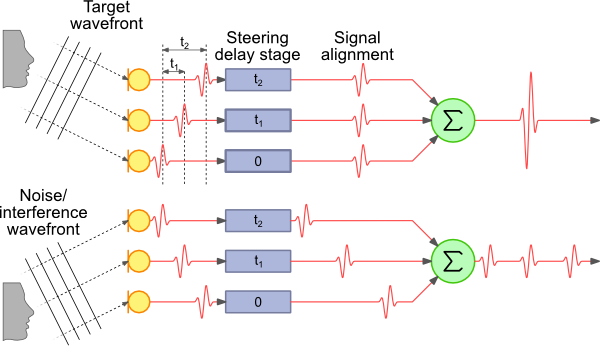TL; DR
Beamforming enhances conference audio by focusing microphone arrays on specific sound sources. This technique isolates speakers and suppresses background noise through constructive interference. It dynamically tracks movement, ensuring clarity even as people shift positions. Beamforming originated in military radar systems and now powers modern communication tools. While improving speech intelligibility, it requires careful calibration and higher costs. Applications span corporate meetings, education, and live events, where clear audio is critical. Advanced solutions like NEARITY’s A20 and C30R integrate AI-driven beamforming for seamless hybrid collaboration. Ideal for noisy environments, the technology balances trade-offs to deliver professional-grade conferencing experiences.
In a crowded meeting room—or even a quiet one—traditional microphones pick up every sound in their vicinity: shuffling papers, air conditioning hum, footsteps, and the voices you actually want to hear. Beamforming changes the game by using multiple microphones (an antenna array for wireless systems) to “focus” on sound from a specific direction, boosting clarity and reducing background noise through spatial filtering. It’s like having a spotlight for audio.
What is Beamforming Technology?
In plain English, beamforming is a signal-processing technique that uses an array of microphones (for audio) or antennas (for RF) to focus energy in a specific direction rather than broadcasting or receiving equally from all around. In other words, this targeted approach boosts the desired signal while suppressing unwanted noise or interference.
However, how does a beamformed system dynamically “form” a virtual microphone that tracks the speaker’s position in the room instead of one static pickup pattern? Continue to read→
How Beamforming Works
Fundamental Principle Beamforming relies on crafting signals to achieve constructive interference at desired angles while causing destructive interference elsewhere to suppress unwanted noise and signals.
Microphone Array Example (Source) Consider a microphone array to illustrate this process. Below are two sensitivity patterns:
- Omnidirectional Microphone An ideal omnidirectional mic picks up sound equally from every direction.
- Focused Array A beamforming array concentrates its sensitivity in one direction, reducing pickup from all others. This “listening” focus allows you to isolate signals coming from a specific angle.

Do you want to learn more about 360 omnidirectional microphones? Click the ultimate guide to 360 Omnidirectional Mics 2025.
A simple way to realize this is with a linear array of microphones — say, three elements spaced evenly. The arrival time of a sound wave differs depending on its angle of incidence:
- –45°: the left mic “hears” the sound first
- 0° (broadside): all three mics receive the signal simultaneously
- +45°: the right mic leads
When you sum the outputs of all mics, signals arriving in phase (i.e., simultaneously) reinforce one another, yielding a high combined amplitude. Signals from off-axis directions arrive out of sync, so their summed amplitude is lower.

Electronic Beam Steering By default, the array’s strongest response (main lobe) points broadside (0°). To steer this main lobe without physically moving the hardware, we introduce time delays:
- Delay Stage Each microphone’s signal passes through a programmable delay.
- Delay-and-Sum Delays are chosen so that waves from a target direction align in time when summed.
Adjusting these delays electronically “aims” the beamformer toward any desired angle.

Next Steps That covers the basics of microphone-array beamforming. There are three primary beamforming approaches — each with its own methodology. For a deeper dive, check our detailed blog post here.
The History of Beamforming
Beamforming isn’t a 21st-century invention—it dates back to radar and sonar systems in the 1940s. Military engineers discovered that by arranging multiple antennas in a line and adjusting the phase of signals, they could detect targets with pinpoint precision. Over time, this phased array principle migrated into wireless communications (MIMO systems) and, eventually, conferencing gear.
- 1940s–1950s: Phased-array radar uses beam steering for target tracking.
- 1990s: Wireless industry adopts beamforming for improved Wi-Fi and 3G networks.
- 2010s: Conference-camera and microphone manufacturers integrate beamforming to tackle meeting-room acoustics.
Thanks to advances in digital signal processing chips and software algorithms, what once required massive hardware setups now fits neatly inside sleek conference devices.
The Pros and Cons of Beamforming
Like any technology, beamforming comes with trade-offs. Let’s weigh them out.
Pros
- Enhanced Speech Clarity: Focused pickup boosts intelligibility, especially in large rooms.
- Noise Reduction: Spatial filtering cuts down ambient sounds, creating a cleaner audio experience.
- Automatic Speaker Tracking: Adaptive beamforming follows people as they move, so you don’t have to fiddle with mics.
Cons
- Cost: Beamforming devices are pricier than basic omnidirectional microphones.
- Complexity: Deployment can require careful calibration and room analysis.
- Edge Cases: Very close talkers or multiple speakers at once may confuse the algorithm, leading to occasional drop-outs.
For most conference environments—especially those with hybrid participants—beamforming’s benefits outweigh its drawbacks. But if you’re on a tight budget or have a static setup where everyone stays in one spot, simpler options might suffice.
The Applications of Beamforming in Conference Meetings
Beamforming’s directional magic finds use across multiple domains:
- Corporate Conference Rooms: Clearer remote and in-room audio, fewer “Can you repeat that?” moments.
- Education: Lecture capture systems use beamforming to isolate instructors, even in large auditoriums.
- Event Production: Live sound mixers employ beamforming mics to minimize stage bleed from monitors and drums.
- Wireless Networks: Massive MIMO uses beamforming to boost 5G and Wi-Fi performance (read our guide to 5G network design for more).
Wherever human speech matters—especially in noisy or reverberant spaces—beamforming elevates the experience. NEARITY endeavors to enabling exceptional conferencing and collaboration experiences with the forllowing company’s flagship audio and camera solutions:
- NEARITY’s A20 USB-powered speakermic elevates virtual meetings with its eight-element microphone array and AI-driven noise suppression, which intelligently filters out ambient sounds while enhancing speech clarity. It works straight out of the box—no drivers needed—and can be daisy-chained alongside other NEARITY units for expanded coverage.
- The NEARITY C30R combines a 4K camera (120° ultra-wide lens) with advanced video capabilities—speaker tracking, dynamic grouping, and auto-framing—and pairs them with a five-element mic array, full-range HD speaker, echo cancellation, automatic gain control, and AI noise reduction to deliver crisp, professional-quality audio and video in a single all-in-one unit.
- Built for small to mid-sized meeting spaces, the NEARITY V30 4K UHD conference camera features an 8 MP sensor, a 120° distortion-free wide-angle lens, and a four-element microphone array. Its intelligent auto-framing and AI-based noise-reduction functions ensure both visuals and speech come through with exceptional clarity.
People Often Ask
Let’s tackle some common questions head-on.
What is the difference between MIMO and beamforming?
- MIMO (Multiple Input, Multiple Output): A wireless communication technique that uses multiple transmitters and receivers to send parallel data streams, boosting throughput and reliability.
- Beamforming: A signal processing method that focuses energy in a specific direction to improve signal strength and reduce interference.
In wireless networks, beamforming can be a feature within MIMO systems, steering each data stream toward its intended device.
How does beamforming work in 5G?
5G leverages massive MIMO, packing dozens—or even hundreds—of tiny antennas in a base station. Adaptive beamforming algorithms then direct narrow, high-gain beams toward individual users, boosting coverage and data rates while reducing interference across the network.
What is the difference between beamforming 5G and LTE?
- LTE beamforming: Typically uses fewer antennas and broader beams.
- 5G massive MIMO: Employs large antenna arrays with much narrower, highly adaptive beams, enabling higher frequencies (mmWave) and ultra-low latency.
How do I disable beamforming?
Most conferencing devices allow you to toggle beamforming in their setup menus or companion apps. If you need to turn it off—perhaps for troubleshooting—look under Advanced Audio Settings and switch from “Auto Beamforming” to a fixed pattern like “All-Around” or “Omni Mode.” Consult your device’s user guide for exact steps.
Conclusion
Beamforming is the unsung hero of today’s connected world, from crystal-clear conference calls to lightning-fast 5G and beyond. By steering and shaping waves—whether acoustic or RF—it transforms how devices communicate, listen, and interact in noisy, crowded environments.
Key takeaways:
- Beamforming is all about focusing energy—improving SNR and user experience.
- Its evolution spans over a century, from Braun’s phased arrays to today’s digital MU-MIMO.
- The trade-offs (cost, complexity, power) are well worth it for the gains in clarity and capacity.
- Whether you’re shopping for a new conference camera, upgrading your Wi-Fi mesh, or deploying 5G infrastructure, understanding beamforming helps you make smarter choices.
Here’s to clearer calls, faster data, and a future that listens (and speaks) brilliantly! ✨🎉












